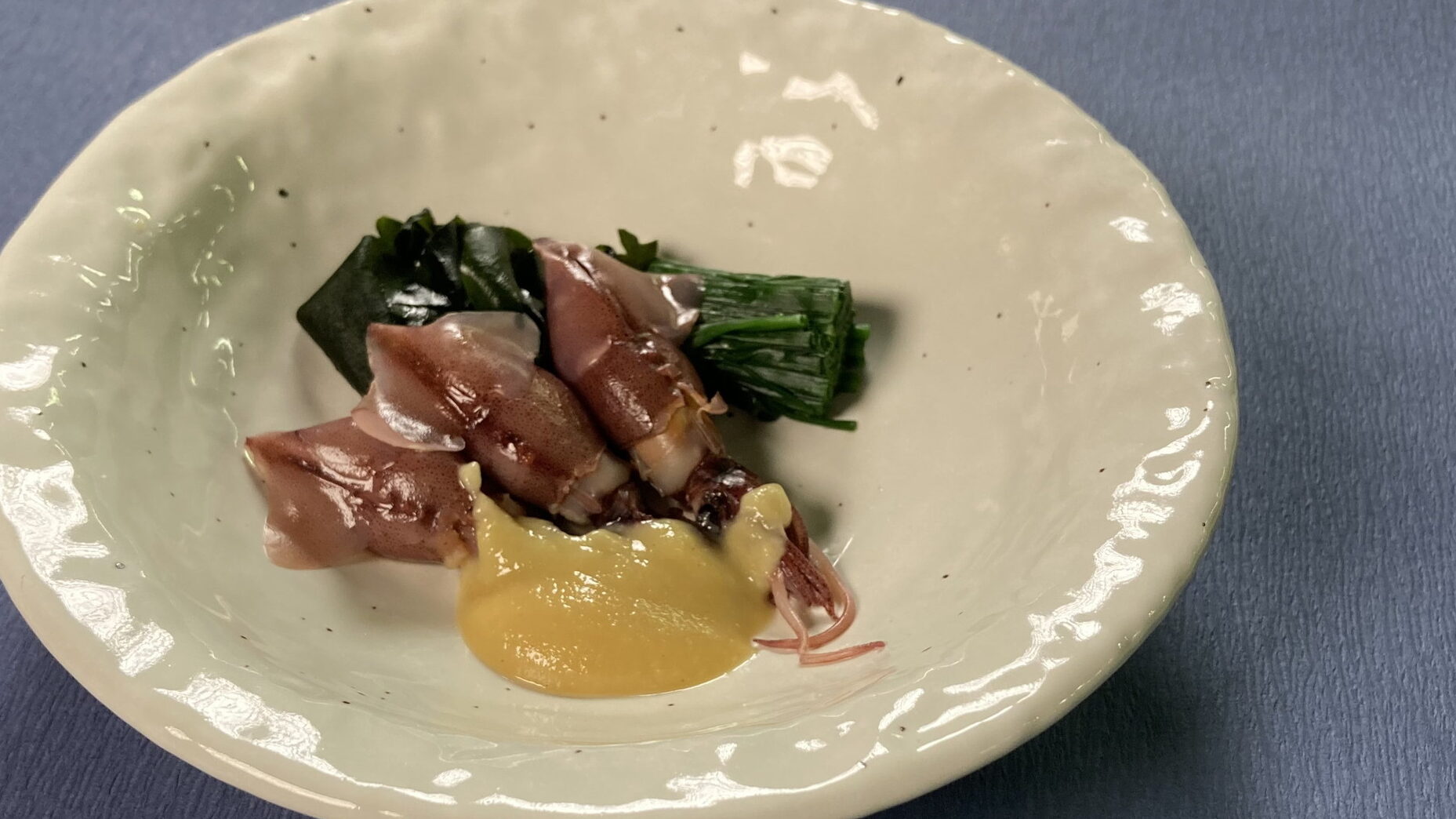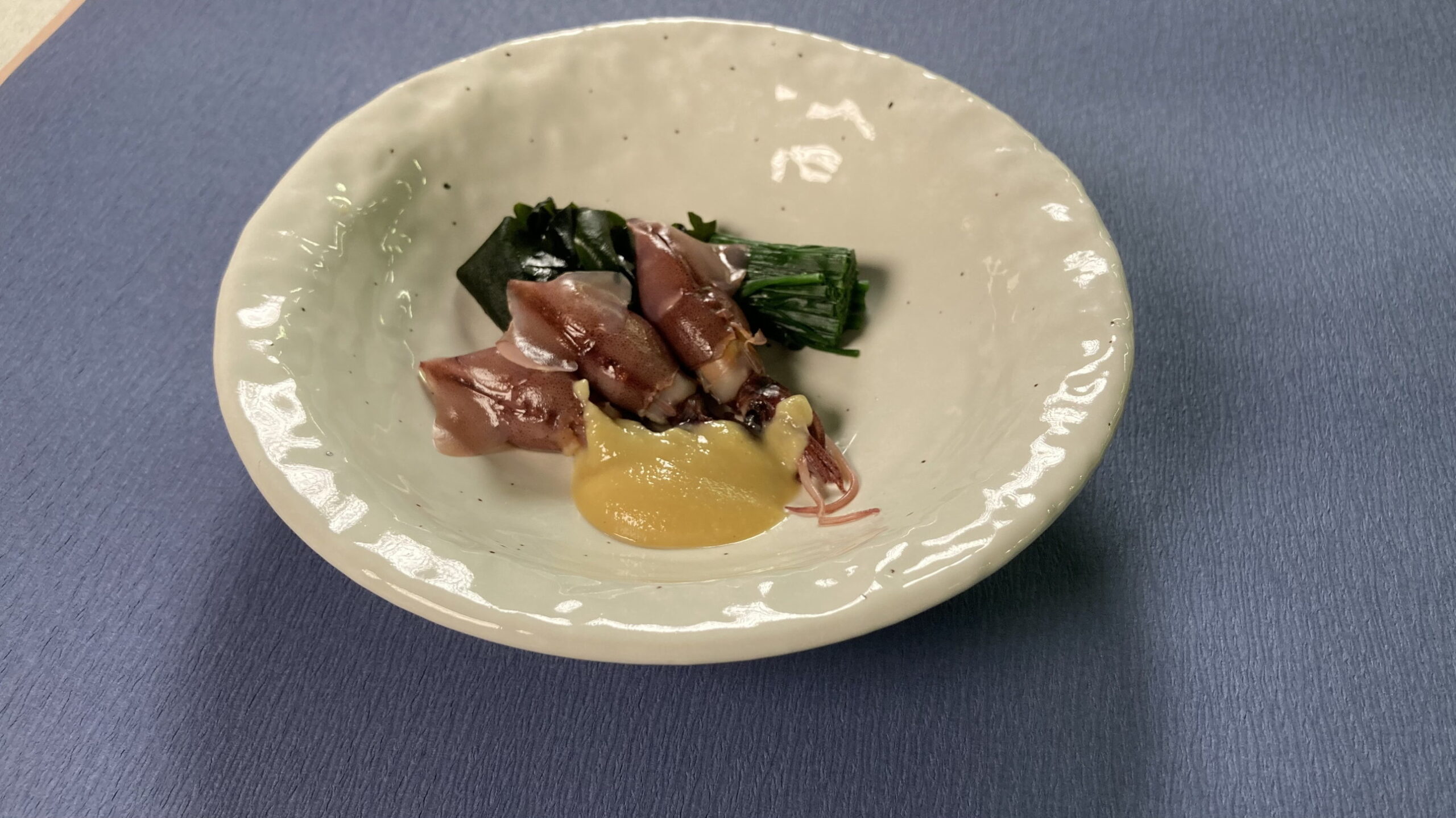
As the chill of winter fades, Toyama Bay comes alive with the mesmerizing glow of firefly squid. These small, bioluminescent creatures gather along the coast to spawn, marking the arrival of spring. “Hotaruika no Su-miso Ae,” or firefly squid with vinegared miso, is a quintessential dish of Toyama, celebrated for its fresh, delicate flavors and the unique texture of the squid.
Dish Name: Firefly Squid with Vinegared Miso
- Region / Location: Toyama Prefecture, Japan
- Primary Area of Tradition: Throughout Toyama Prefecture
- Main Ingredients: Firefly squid, wakegi (a type of scallion), karashi-sumiso (mustard vinegared miso)
How It’s Eaten / Served
The firefly squid are briefly boiled and their eyes are usually removed before eating (though at home, people often remove them individually as they eat). Boiled wakegi, cut into easy-to-eat lengths, is arranged with the squid, and then generously drizzled with karashi-sumiso, a tangy and slightly spicy dressing made from miso, vinegar, mustard, and sugar. Some people also like to add wakame seaweed, myoga ginger, or regular ginger for extra flavor and texture.
Cultural Background and Preservation
Firefly squid fishing in Toyama Bay has a long history, with records dating back to the Edo period in Namerikawa, a town boasting one of the highest catches in the prefecture. The sight of these blue-white glowing squid swarming the shallow waters is so remarkable that the “Firefly Squid Swarming Grounds” are designated as a Special Natural Monument of Japan. Toyama Bay’s fixed net fishing method ensures minimal damage to the squid, and the proximity of the fishing grounds to the ports guarantees exceptional freshness. During the fishing season, efforts are even made to protect the squid by preventing the flow of paddy field water into the sea. “Hotaruika no Su-miso Ae” is a beloved way to enjoy the fresh, spring bounty. It’s a common sight on family tables in port towns during the fishing season (March to June) and is also served as a colorful appetizer when entertaining guests. It’s an indispensable accompaniment to sake. Besides being a home-cooked favorite, it’s widely available in Toyama restaurants as a seasonal delicacy, and numerous online recipes have increased its recognition even outside the prefecture. Initiatives are also underway to ensure the continuation of fixed net fishing, including recruitment and training for those interested in carrying on this tradition.
Additional information:
- Wakegi: A type of Japanese bunching onion, similar to scallions but with a slightly milder flavor.
- Karashi: Japanese mustard. It has a sharp, pungent flavor that is distinct from Western mustards.
- Miso: A traditional Japanese seasoning produced by fermenting soybeans with salt and koji (a type of mold). It has a savory, umami-rich flavor.
- Sumiso: A type of vinegared miso sauce, often used as a dressing for seafood and vegetables.
- Umami: One of the five basic tastes (along with sweet, sour, bitter, and salty). It is often described as savory or meaty.
The information about regional cuisine featured on this website (Piggy's Grandma of Japan) is summarized and adapted from the Ministry of Agriculture, Forestry and Fisheries of Japan (MAFF) website, "Our Regional Cuisines"Additional commentary is provided based on the unique experiences and perspectives of the site's editors.
The copyright for the original content regarding regional cuisine belongs to the Ministry of Agriculture, Forestry and Fisheries of Japan.
The summaries and adaptations published on this site are intended for informational purposes only. Piggy's Grandma of Japan does not guarantee the accuracy or completeness of this information. For the most accurate and complete details, please refer to the original pages on the MAFF website.


